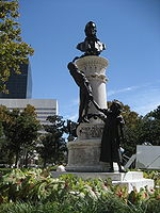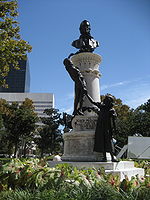
McDonogh Day Boycott
Encyclopedia
The McDonogh Day Boycott on 7 May 1954 was a protest
by African American public school students, teachers, and principals in New Orleans. It was one of the city's first organized civil rights
protests.
 McDonogh Day was, and remains to a very limited extent, a ritual in the New Orleans Public Schools
McDonogh Day was, and remains to a very limited extent, a ritual in the New Orleans Public Schools
. In May of every year, delegations of students would be brought to Lafayette Square, in front of what was then City Hall
, to participate in a ceremony paying homage to the late John McDonogh
, a 19th-century philanthropist
who had endowed many of the public schools in the city.
In the 1950s, the school system was racially segregated
. On McDonogh Day, delegations from white schools would perform their ritual functions—place flowers at the McDonogh statue, sing, receive keys to the city from the mayor
—and leave. Delegations from black schools, meanwhile, had to wait for a separate ceremony afterward, often standing all the while in hot, muggy, or otherwise uncomfortable New Orleans weather.
As McDonogh Day approached, black teachers' associations voiced protest over the procedure. Arthur Chapital, director of the local branch of the NAACP, called for a boycott. He urged Revius Ortique, Jr
, an African American labor leader, to make radio broadcasts asking parents to keep their children home on McDonogh Day.
The boycott was near-total. Of 32,000 African American students in the system, only 34 attended, along with one principal. Mayor Chep Morrison
was left holding surplus keys to the city.
The protest was repeated for another two years.
Protest
A protest is an expression of objection, by words or by actions, to particular events, policies or situations. Protests can take many different forms, from individual statements to mass demonstrations...
by African American public school students, teachers, and principals in New Orleans. It was one of the city's first organized civil rights
Civil rights
Civil and political rights are a class of rights that protect individuals' freedom from unwarranted infringement by governments and private organizations, and ensure one's ability to participate in the civil and political life of the state without discrimination or repression.Civil rights include...
protests.

New Orleans Public Schools
New Orleans Public Schools is a public school system that serves all of New Orleans, Louisiana, United States. Schools within the system are governed by a multitude of entities, including the Orleans Parish School Board , which directly administers 4 schools and has granted charters to another 12,...
. In May of every year, delegations of students would be brought to Lafayette Square, in front of what was then City Hall
City hall
In local government, a city hall, town hall or a municipal building or civic centre, is the chief administrative building of a city...
, to participate in a ceremony paying homage to the late John McDonogh
John McDonogh
John McDonogh was a United States entrepreneur and philanthropist, described as miserly, controversial, and eccentric. He is most famous for endowing public education in two major American cities—New Orleans and Baltimore.-Life and career:McDonogh was born in Baltimore and entered the...
, a 19th-century philanthropist
Philanthropist
A philanthropist is someone who engages in philanthropy; that is, someone who donates his or her time, money, and/or reputation to charitable causes...
who had endowed many of the public schools in the city.
In the 1950s, the school system was racially segregated
Racial segregation
Racial segregation is the separation of humans into racial groups in daily life. It may apply to activities such as eating in a restaurant, drinking from a water fountain, using a public toilet, attending school, going to the movies, or in the rental or purchase of a home...
. On McDonogh Day, delegations from white schools would perform their ritual functions—place flowers at the McDonogh statue, sing, receive keys to the city from the mayor
Mayor
In many countries, a Mayor is the highest ranking officer in the municipal government of a town or a large urban city....
—and leave. Delegations from black schools, meanwhile, had to wait for a separate ceremony afterward, often standing all the while in hot, muggy, or otherwise uncomfortable New Orleans weather.
As McDonogh Day approached, black teachers' associations voiced protest over the procedure. Arthur Chapital, director of the local branch of the NAACP, called for a boycott. He urged Revius Ortique, Jr
Revius Ortique, Jr
Revius Oliver Ortique, Jr. was an American jurist, first Afro-American justice of the Louisiana Supreme Court, and civil rights activist....
, an African American labor leader, to make radio broadcasts asking parents to keep their children home on McDonogh Day.
The boycott was near-total. Of 32,000 African American students in the system, only 34 attended, along with one principal. Mayor Chep Morrison
De Lesseps Story Morrison
DeLesseps Story "Chep" Morrison, Sr., was the mayor of New Orleans from 1946-1961 who failed in three hard-fought bids for the then-pivotal Louisiana Democratic gubernatorial nomination. He also served as an appointee of U.S. President John F. Kennedy as the United States ambassador to the...
was left holding surplus keys to the city.
The protest was repeated for another two years.

